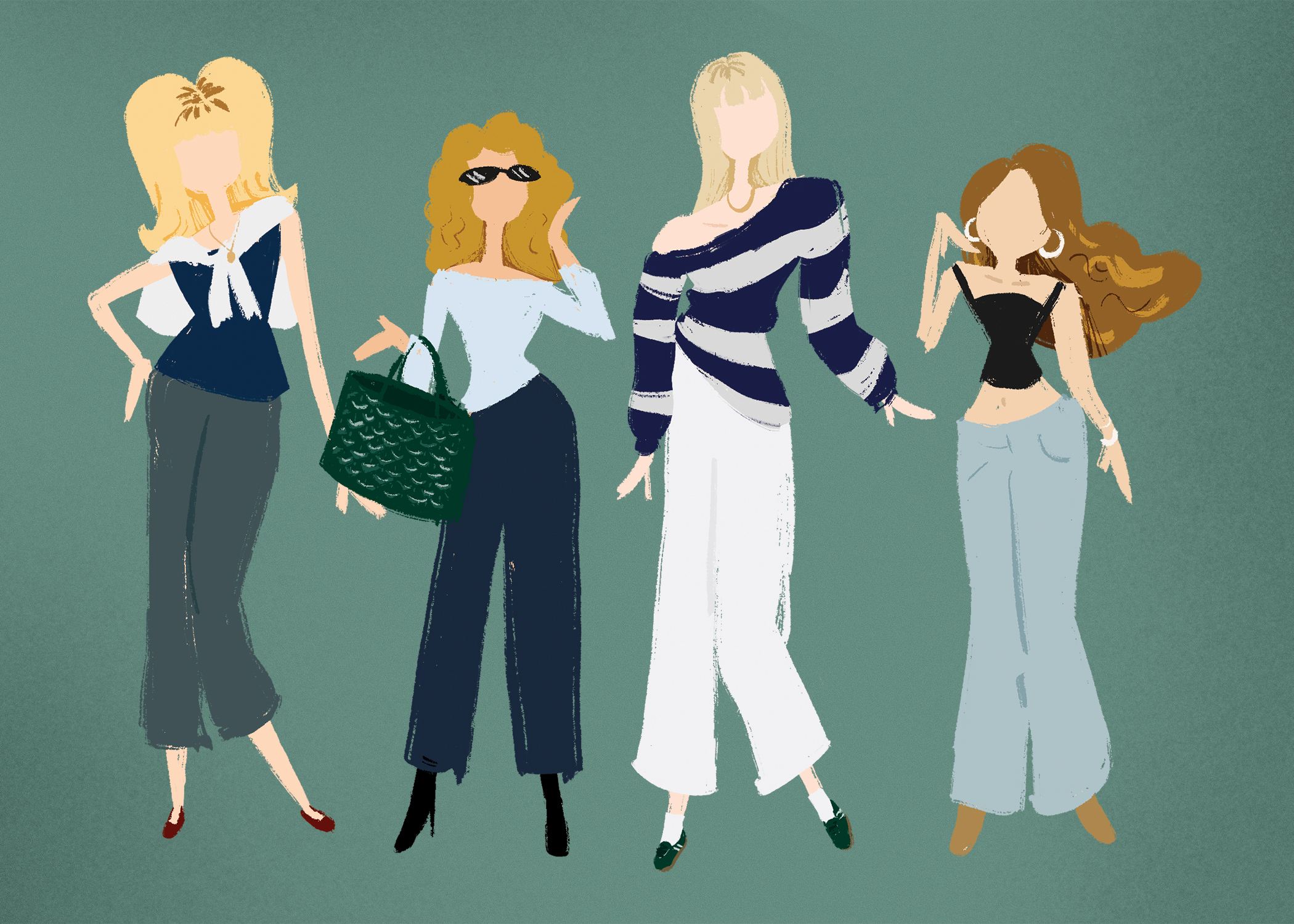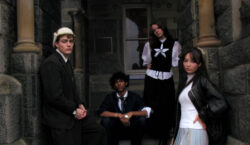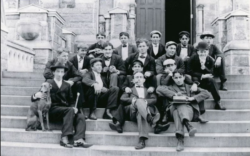‘Twas a crisp 68-degrees in Washington, D.C on Friday, Oct. 18, 2024. Students spilled out the doors of White-Gravenor, grateful to be done with their classes. From the Maker Hub wafted an aroma of pumpkin spice lattes and hot glue, as people bustled about, working on their DIY Halloween costumes. Freshmen skipped with joy across Copley Lawn in anticipation of reuniting with their loved ones from home over Parent & Family Weekend.
But beneath it all, something was brewing. Soon, a class war would erupt in the comments of a @georgetownuniversity Instagram reel; And it would all be because of a purse.
It wasn’t just any purse, however. No, it was a Goyard tote bag worth $1,500. The video—a vlog depicting a student studying for midterms—was a likely-accidental but nonetheless glaring display of consumerism. It begins with a shot of the infamous bag on her dorm room desk, before panning to an Erewhon tumbler, which she fills with Trader Joe’s Pumpkin Spice Cold Brew Concentrate, almond milk, and pebbles from a state-of-the-art ice machine. Upon arrival at an MSB study room, she unpacks an Apple ecosystem—Macbook, iPhone, iPad, and Airpod Maxes—as she gets to studying, her $1,250 Cartier LOVE Ring creeping into frame.
The comments came flooding in. “someone with a $1.5k bag was not who i would’ve picked to do this video [sic],” wrote one user. Another commenter expressed similar disappointment, recalling her experience as a first-generation low-income student: “As an alumni I’m disheartened by this post. This is the exact reason I never felt included in this school [sic].”
And I do agree, at least where it matters. This video was posted by the official Georgetown Instagram account, which means that the video—now dubbed Goyard-gate among students—was selected to be a presentation of the school’s image. To frame your institution through such a lens of materialism is to exclude those who cannot afford luxuries such as an ice machine or $500 headphones, whether intentionally or not.
But at the same time, is it an unrealistic or false representation of Georgetown? I say no. The creator of Goyard-gate is hardly an outlier, at least in her choice of handbag. I would posit that, in each of the classes I’ve taken at Georgetown so far, at least one of my classmates has that same bag. To quote an anonymous user on Fizz, “yall acting like this fuckass green bag isn’t gtown’s second mascot at this point [sic].”
The unfortunate truth is that Georgetown fashion is full of status symbols. Goyard tote bags (~$1,500-$2,000), Cartier LOVE Rings (~$1,200-$2000), Van Cleef motif necklaces (~$2,800-$8,900+), Golden Goose sneakers (~$600), Ralph Lauren Polo Bear sweaters (~$400). If you’ve been keeping track, we’re at a minimum of about $6,500 for an outfit that you may not even give a second glance on this campus.
Outside of clothing items, regular upkeep on gel manicures and blonde root touch-ups can add up to thousands of dollars each year. Even when looking at cheaper Georgetown staples, other forms of exclusivity arise, such as the one-size-fits-(sm)all Brandy Melville, which is a convenient five-minute walk from campus. In truth, to be trendy at Georgetown is to be skinny, rich, and white.
I found that I am not the only one with concerns about our campus’s style. Daniel Chernyak’s (CAS ‘28) experience as a Georgetown Scholars Program (GSP) member has shaped his view of campus fashion trends, noting that, generally, the types of outfits students wear on campus remain consistent across different income levels; the key differences arise in the form of status symbols, like the Goyard bag.
“I can very much differentiate what type of wealth you are based on your purse,” Chernyak explained. “Because if somebody’s walking around with a Goyard bag or a Louis Vuitton purse that’s screaming Louis Vuitton, I’ll know that it’s somebody who’s either upper middle class who has the money to spend on designer and wants people to know about it, or somebody who’s newer money, because they really feel the need to signal their wealth.”
The performance of wealth was a frequent issue brought up in my conversation with Chernyak, who resents the public nature of wealth signifiers on campus.
“There’s a difference between, ‘You’re just rich and you can just afford things’ versus ‘You actively showing it off in what you’re wearing,’ that I think is a very major distinction between people on this campus,” he said.
Regarding the infamous Goyard-gate video, Chernyak expressed a similar sentiment, feeling frustration not in the student’s wealth but the university’s choice to showcase a very specific, privileged Georgetown experience.
“I don’t think they’ve ever done a day-in-my-life of a low-income student, and we exist on this campus,” he said. “If you’re a university who’s trying to pride yourself on caring about the whole person and offering equal opportunities, you should show some of the [days-in-the-life] of somebody who’s not wealthy and doesn’t have needlessly overpriced bags and an ice machine in their dorm. It would still be an interesting video—we aren’t boring people, we do cool things.”
However, when it comes to day-to-day life at Georgetown, Chernyak still offers a fairly optimistic view, suggesting that it is possible to be on-trend and achieve the expensive look without the means to afford an costly designer wardrobe: “A lot of my low-income friends are very good at masking, just a bit. ‘Cause if you know where to shop and the silhouette you’re looking for, you can do a lot with a little, and nobody will really know.”
But, ultimately, why does being “on-trend” matter at all? In my opinion, the answer lies in the school’s ever-present culture of conformity.
“[Georgetown fashion is] preppy. It’s quite clean. It’s very standardized,” Margie Connor (SON ‘28) said. “When you look around, you’ll see a lot of people wearing a lot of neutrals, a lot of things that look close to the same kind of clothes.”
For Connor, the pressure to fit in with Georgetown’s homogenous fashion had come head-to-head with her personal fashion sense, which used to be a “romantic goth” style—incorporating dark lace and velvet, long skirts, dyed hair, and large silver jewelry—before enrolling.
“I started changing the way I dress because I became very aware—through Tik Tok, social media, just seeing pictures of Georgetown online, and information about [the school]—that people kind of had a way of dressing,” she said. “I was like, ‘Oh, I don’t want to ever feel uncomfortable not fitting into that standard,’ and so I changed a lot about myself. I’m not unhappy with the way I dress now, but I’d say that before I was able to express myself in a way that felt a lot more free for me.”
Now, she describes her style as “a mix of fashions,” pulling inspiration from “florals,” “lighter colors,” and “seventies influence,” and while she doesn’t consider herself to be fully aligned with the preppiness of Georgetown trends, she does feel that her more toned-down style allows her to blend in more than her previous look would have.
For many students like Connor, the pressure to blend in can be overwhelming, making it difficult for students to simply have fun and experiment with their personal style. The standard dress code follows the same cookie cutter formula—a blue/white/gray color palette, tailored jeans, heeled boots or ballet flats, a sweater draped over the shoulders, and at least one of the aforementioned status symbols.
If your style is slightly different—maybe you dress in a more “basic” way but don’t achieve the expected level of polish—you risk being labelled unfashionable. Or if you embrace any form of self-expression—through slightly dramatic makeup, colored hair, or bolder fashion choices—you’re quickly categorized as distinctively edgy or alternative, even though you don’t fit the conventional standards of those groups.
It’s sad, really. College should be an environment for experimentation and self-discovery, not conformity. Personal style is one of the most accessible and powerful tools of self-expression—and yes, it’s also the most public. But that’s exactly why we should embrace it.
There will be plenty of chances later in life to dress like a wealthy mother of three in the Hamptons. Right now, we should take risks. Play with color. Explore different silhouettes. Finally wear that statement piece in the back of your closet. Find the style that feels like you, not like Georgetown. And maybe, if we could transform Georgetown into a more vibrant campus, we could become a school whose fashion isn’t defined by an expensive green bag but by the individuality of the students who bring it to life.






